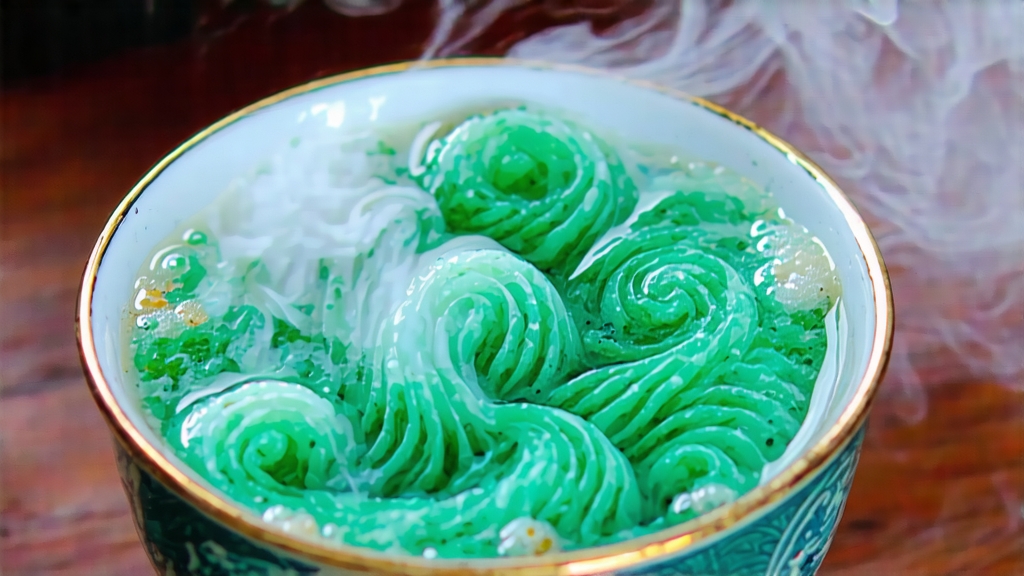
Biluochun, whose name translates literally to “Green Snail Spring,” is one of China’s ten most celebrated teas, yet it remains a quiet mystery to many outside the Middle Kingdom. Produced exclusively in a micro-zone where the provinces of Jiangsu and Zhejiang pinch the eastern edge of Lake Tai, this tea is prized for its improbably tiny, spiral-shaped leaves and an aroma so fragrant that court poets of the Qing dynasty claimed it “competes with the first peach blossom of the year.” To understand Biluochun is to listen to a 1,200-year conversation between monks, emperors, tea gardeners, and the cool lake mists that roll across Dongting Mountain at dawn.
History and Legend
The first verifiable record appears in the Tang dynasty’s “Classic of Tea,” but legend pushes the story back further. A nun named Lingji is said to have discovered wild tea trees whose leaves exuded a natural fruity perfume. She picked a handful, brewed them in a bamboo bowl, and offered the liquor to a traveling governor; the official was so moved that he petitioned the court to grant the tea imperial status. By the Kangxi era (1662–1722) the emperor—tired of the homophonic original name “Xia Sha Ren Xiang,” literally “scary fragrance”—rechristened it Biluochun for its snail-shell curl and spring harvest. The new name stuck, and tribute quotas soared to 900 kilograms a year, all carried to Beijing by canal boat and horseback within three weeks of plucking so the Forbidden City could taste the season’s first freshness.
Micro-Terroir: Why Only Dongting Shan?
Lake Tai acts as a gigantic solar battery, storing daytime heat and releasing it at night. The surrounding hills trap cool vapor, creating a mist that filters sunlight into a soft, diffused glow. Tea bushes interplanted with peach, plum, and loquat trees absorb floral volatiles through their leaf pores, giving the finished tea its signature orchard note. Soil is a lean, slightly acidic sandy loam derived from weathered quartz; drainage is so rapid that roots are forced to struggle, concentrating amino acids—especially L-theanine—responsible for sweetness and umami. Within the officially mapped 110 km² core zone, elevation ranges only from 50 m to 300 m, yet every 30 m of ascent shifts harvest date by roughly one day, allowing the skillful planter to stage picking over three weeks without leaving the village.
Cultivars: Two Sisters and a Wild Cousin
The classic cultivar is Dongting Small-Leaf #1, a landrace selected for millennia that keeps its tips microscopic—500 grams of finished tea contains roughly 70,000 buds. In the 1980s researchers released Wuniuzao, an early-sprouting variety that ripens seven days ahead, letting farmers capitalize on the lucrative Qingming Festival market; connoisseurs find it less complex. A third, increasingly rare strain, Ye-Biluochun, grows semi-wild on rocky cliffs and is harvested only every other year; its liquor carries a faint rosemary note that some liken to Provence in spring.
Plucking Discipline: One Bud, One Leaf, One Heart
Harvest begins when the overnight temperature stabilizes above 10 °C, usually between 15 March and 10 April. Pickers work a 4-hour window starting at 5:30 a.m., before the sun burns off the mist. Standard is “one bud plus the unfolding leaf immediately below,” no longer than 2.5 cm. Leaves are laid in shallow bamboo baskets lined with mosquito-net silk; any compression triggers premature oxidation and forfeits the precious jade color. A seasoned picker gathers barely 600 g of fresh leaf per session—150 g after firing—so a single day’s wage rides on fingertips trained since childhood.
Crafting the Spiral: Six Hours That Stop Time
Within 30 minutes of plucking, the leaf reaches the village workroom where three masteries—withering, killing-green, and coiling—unfold in one uninterrupted performance.
-
Mist Withering (20 min): Leaves are spread on hemp cloth under a latticed ceiling; fans draw lake-cooled air through the room, reducing moisture from 76 % to 68 %. The goal is limpness without bruise.
-
Hand-Firing in a 180 °C Wok (4 min): The fryer—always a woman, tradition claims, for steadier wrists—tosses 250 g batches